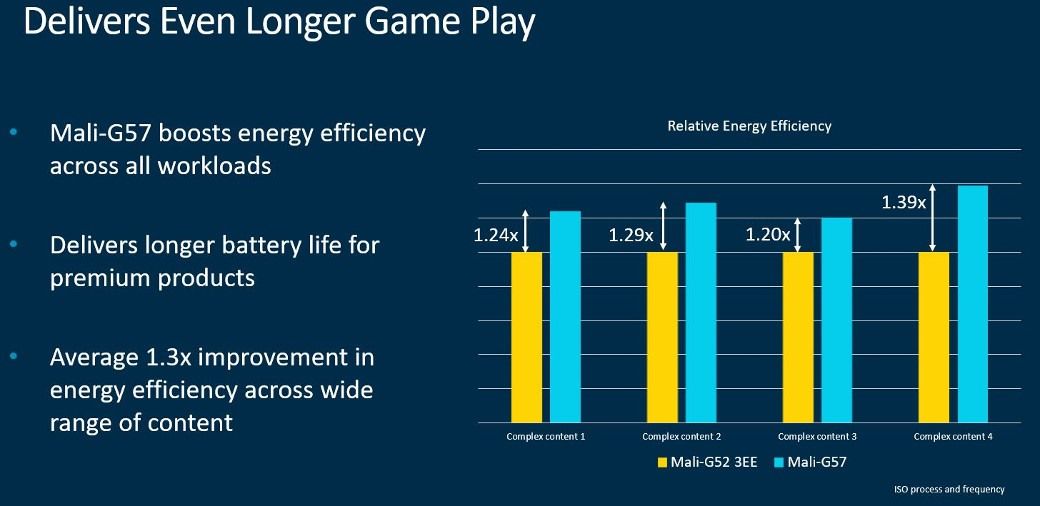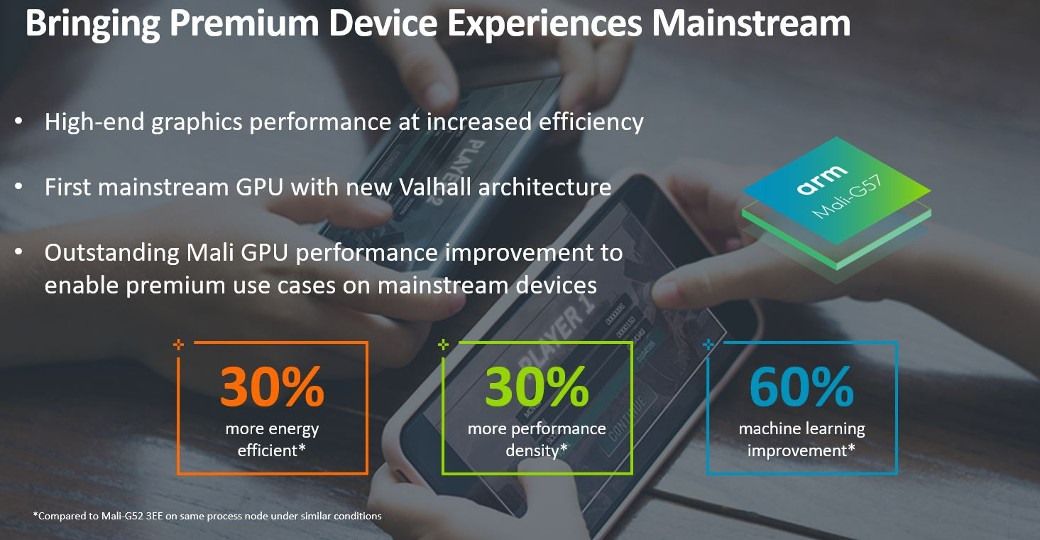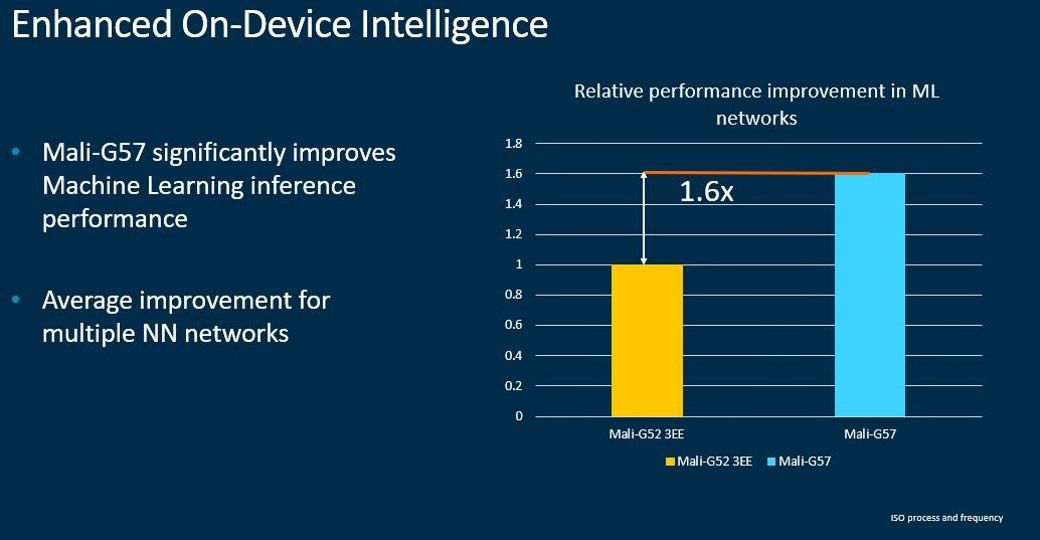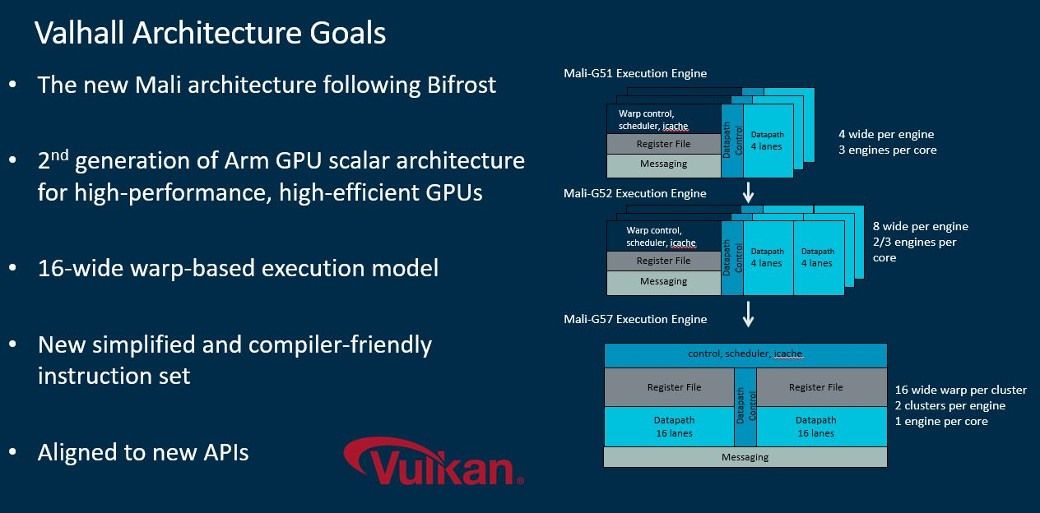In May, ARM announced the ARM Cortex-A77 CPU architecture and the ARM Mali-G77 GPU. The Mali-G77 GPU is the first GPU to feature the new "Valhall" architecture, which succeeds the Bifrost architecture that has been powering ARM's GPUs since 2016. The premium Mali-G77 will show up as part of Samsung's brand new Exynos 990 flagship SoC, but ARM also develops mid-range, mainstream GPUs that are intended for affordable devices. The last such mid-range ARM GPU was the ARM Mali-G52, which found its way to the HiSilicon Kirin 810. Now, ARM has announced its successor, the Mali-G57 GPU, and it's the first mainstream ARM GPU to feature the Valhall architecture.
According to ARM, the Mali-G57 enables premium features such as high fidelity content, console-like graphics on phones, and more complex ML, AR, and VR workloads. It does this by bringing the performance improvements that we have come to expect from higher-end GPUs. Compared to the Mali-G52, the Mali-G57 offers a 30% better performance density across a range of content ranging from games to high-res 2D content, and it also has double the texturing performance. ARM says that this "greatly improves the performance for high-resolution UI in 4K and 8K DTVs, AR and VR and gaming". It's also said to be a great choice to tackle more complex 3D workloads, such as physically based rendering (PBR), HDR rendering, and volumetric effects.
More importantly, ARM claims to have made "significant energy efficiency improvements". The company's past premium GPUs, such as the Mali-G71 and the Mali-G72, have historically had poor energy efficiency. The Mali-G57 claims to have 30% better energy efficiency as compared to the Mali-G52, which should improve battery life.
ARM's priority is cost-efficiency. The company states that while the Mali-G77 has at least seven cores, the Mali-G57 has one to six cores depending on the configuration. This should make it suitable for mainstream phones - for example, the Kirin 810 uses a six-core version of the Mali-G52.
ARM is also talking about machine learning (ML) performance. The Mali-G77 improved ML performance by up to 60%, and the Mali-G57 is said to make "similar" improvements. The 60% increase in on-device ML performance is enabled by 2x more FMAs when compared to the Mali-G52, as well as architectural optimizations. According to ARM, this provides faster responsiveness to ML use cases such as speech recognition, face detection, and image quality enhancement, with the flexibility to perform different ML workloads.
The company then moves on to talk about AR and VR. While AR is still a fledgling subject on smartphones, VR is generally held by the industry to be as good as buried already, what with the death of Google Daydream and the general lack of consumer interest in smartphone VR. However, the Mali-G57's increase in performance and the inclusion of new technologies helps in providing improved AR and VR experiences, according to ARM.
Finally, ARM talks about the Valhall GPU architecture. Naturally, the company says that it's crucial for developers because it has been designed to align with modern APIs such as Vulkan. ARM promises that games will run smoother and for longer on devices thanks to the performance and energy efficiency improvements of the Mali-G57. The Valhall architecture is the current basis of ARM's latest-generation GPUs, and more details about it can be read in the Mali-G77 launch article. The key features of the architecture consist of a new superscalar engine, a simplified scalar ISA, and dynamic scheduling of instructions - these factors are the key to enable the performance and energy efficiency improvements that ARM proclaims are in the Mali-G57.
Qualcomm uses its own Adreno GPUs in smartphones, while Samsung Systems LSI, HiSilicon, and MediaTek all rely on ARM's Mali GPUs. For example, the Redmi Note 8 Pro's MediaTek Helio G90T SoC features the Mali-G76MC4 GPU. We expect the Mali-G57 to appear in new mid-range GPUs made by the aforementioned three vendors. If it lives up to its promises, it can only be a good thing for the mid-range smartphone GPU market in terms of competition.
Alongside the Mali-G57 GPU, ARM also announced the Ethos-N57 and Ethos-N37 NPUs (Neural Processing Unit) and the Mali-D37 DPU (Display Processing Unit). The latter is said to deliver a rich feature set within "the smallest area" for Full HD and 2K resolution, while the NPUs are dedicated neural processing hardware for smartphones. The N37 and N57 NPUs are optimized for 1 and 2 TOP/S ML performance range.
Source: ARM





